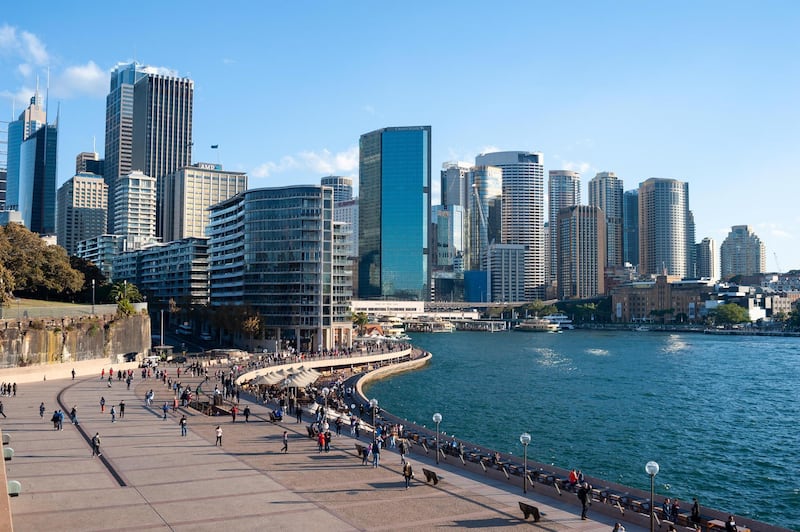Australia is seemingly rushing headlong into another debt-fuelled property binge.
Three interest rate cuts that have taken mortgage rates to a record low and a loosening of lending curbs have sent buyers flocking back to the housing market. At current rates of growth, Sydney home prices could recoup two years of losses and be back at record highs as soon as May.
The sudden turnaround is raising fears of a reinflated property bubble and risks swelling an already worrisome pile of household debt. It’s also further concentrating banks’ reliance on mortgages for earnings growth and entrenching inequality by making it harder for first-time buyers to get a foot on the property ladder.
“It’s a pretty risky point in time,” said Richard Holden, professor of economics at the University of New South Wales. “We had a price correction on the back of a big credit crunch and there was a real question about whether it was going to get out of control. We seem to have averted disaster, which is good news, and now it seems like we’ve decided to test it again.”
In just four months, house prices in the nation’s two largest cities have executed a swift U-turn. Newspapers are again filled with reports of hotly contested bidding wars driving home prices hundreds of thousands of dollars above their reserve.
In August, for example, an auction for a four-bedroom house in the Sydney suburb of Ryde attracted about 100 people. Spirited bidding pushed offers A$226,000 (Dh566,295) above the reserve price, before it finally sold for almost A$1.5 million — a buzz last seen during the boom years.
“A lot more people now are getting concerned that things are going to go up in the next six to 12 months so they’re trying to buy now,” said real estate agent Phil Allison, who handled the sale in the summer. As recently as the beginning of the year, it was difficult to elicit a single bid at an auction for a house just around the corner, he said.
One factor encouraging property investors back was the surprise re-election of Scott Morrison’s government in May, which killed off the opposition Labour party’s plans to wind back tax breaks for landlords.
While the property market’s resurgence could provide a short-term boom to the slowing economy, the longer-term legacy could be bloated debt that permanently reduces the economy’s potential.
As borrowers put more of their income towards servicing their mortgages, they are left with less to spend on everything from cars to appliances to clothes, robbing the economy of a key driver of growth.
Consumer confidence has slumped to a four-year low even as rate cuts and tax rebates boost household finances.
While traditionally a buoyant housing market is good news for retailers, the RBA’s move to slash rates to a record low has shaken consumer sentiment by signalling the economy is in trouble. A profit warning from furniture outlet Nick Scali earlier this month rippled through the market, sending bigger retailers like Harvey Norman Holdings and JB Hi-Fi tumbling.
“Sentiment is still shaky,” says Eleanor Creagh, market strategist at Saxo Capital Markets in Sydney. “Surveys and economic data continue to confirm that over-leveraged consumers who have whittled away their savings and are devoid of any material wage growth are choosing to de-leverage rather than increase spending.”

Historically, homebuyers could rely on annual wages growth of 3 per cent to 4.5 per cent to reduce the proportion of their salary going to pay their mortgage. Now, with wage growth stuck below 2.5 per cent, that’s no longer happening for people who have bought more recently, compounding the drag on consumer spending.
For the banks, a return to house-price growth is usually good news. People borrow more to buy in a rising market, while existing owners may be encouraged to borrow against the increased value of their home to fund renovations.
Longer-term, though, that could fuel mortgage stress. While less than 1 per cent of mortgages are in arrears, according to the Reserve Bank, the number has risen steadily in recent years.
The big four banks, which control almost 80 per cent of the A$1.7 trillion mortgage market, are also under political pressure to pass on the RBA cuts in full and lend more to pump up the economy, stoking concern lending standards could decline.
That’s despite the banks still recovering from a bruising misconduct inquiry, where they were lashed for lax lending standards.
Nonetheless, competition is again hotting up. Westpac Banking is reducing down payment requirements for investors taking out interest-only loans, while Australia & New Zealand Banking Group is trying to grab a bigger slice of the landlord market.
While the property downturn gave first-home buyers a chance to get into the market, that opportunity could already be evaporating. During previous upswings, first-time buyers were gradually squeezed out as home prices rose.
A return to boom-time prices would again slam the door shut on younger buyers, further entrenching generational inequality in Australia.
“The reprieve we’ve had over the last few years could well prove short- lived,” said Brendan Coates, programme director at the Grattan Institute. “The biggest impact of rising house prices is to redistribute wealth from those that don’t own housing to those that do.”








